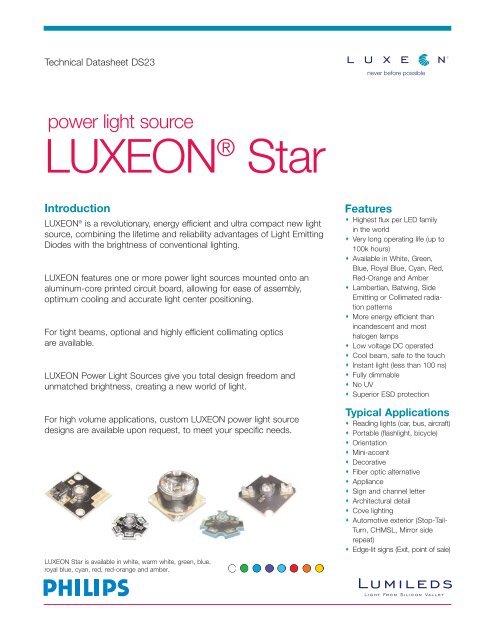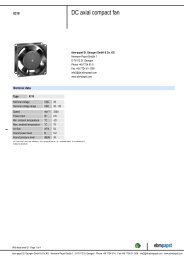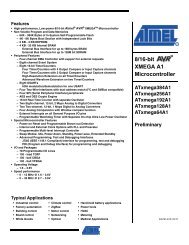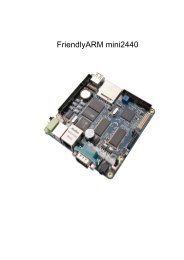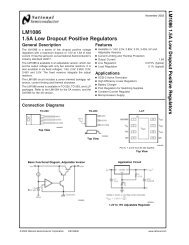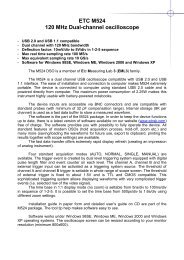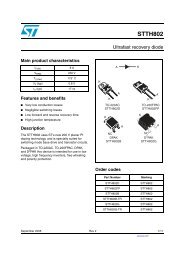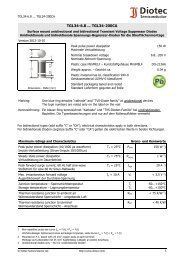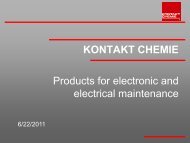Luxeon Star Technical Datasheet
Luxeon Star Technical Datasheet
Luxeon Star Technical Datasheet
Create successful ePaper yourself
Turn your PDF publications into a flip-book with our unique Google optimized e-Paper software.
<strong>Technical</strong> <strong>Datasheet</strong> DS23<br />
power light source<br />
LUXEON ® <strong>Star</strong><br />
Introduction<br />
LUXEON ® is a revolutionary, energy efficient and ultra compact new light<br />
source, combining the lifetime and reliability advantages of Light Emitting<br />
Diodes with the brightness of conventional lighting.<br />
LUXEON features one or more power light sources mounted onto an<br />
aluminum-core printed circuit board, allowing for ease of assembly,<br />
optimum cooling and accurate light center positioning.<br />
For tight beams, optional and highly efficient collimating optics<br />
are available.<br />
LUXEON Power Light Sources give you total design freedom and<br />
unmatched brightness, creating a new world of light.<br />
For high volume applications, custom LUXEON power light source<br />
designs are available upon request, to meet your specific needs.<br />
LUXEON <strong>Star</strong> is available in white, warm white, green, blue,<br />
royal blue, cyan, red, red-orange and amber.<br />
Features<br />
Highest flux per LED family<br />
in the world<br />
Very long operating life (up to<br />
100k hours)<br />
Available in White, Green,<br />
Blue, Royal Blue, Cyan, Red,<br />
Red-Orange and Amber<br />
Lambertian, Batwing, Side<br />
Emitting or Collimated radiation<br />
patterns<br />
More energy efficient than<br />
incandescent and most<br />
halogen lamps<br />
Low voltage DC operated<br />
Cool beam, safe to the touch<br />
Instant light (less than 100 ns)<br />
Fully dimmable<br />
No UV<br />
Superior ESD protection<br />
Typical Applications<br />
Reading lights (car, bus, aircraft)<br />
Portable (flashlight, bicycle)<br />
Orientation<br />
Mini-accent<br />
Decorative<br />
Fiber optic alternative<br />
Appliance<br />
Sign and channel letter<br />
Architectural detail<br />
Cove lighting<br />
Automotive exterior (Stop-Tail-<br />
Turn, CHMSL, Mirror side<br />
repeat)<br />
Edge-lit signs (Exit, point of sale)
Mechanical Dimensions<br />
LUXEON <strong>Star</strong><br />
LIGHT SOURCE<br />
Side Emitting<br />
Batwing<br />
Lambertian<br />
Notes:<br />
1. Slots in aluminum-core PCB for M3 or #4 mounting screw.<br />
2. Electrical interconnection pads labeled on the aluminum-core PCB with "+" and "-" to denote positive and negative,<br />
respectively. All positive pads are interconnected, as are all negative pads, allowing for flexibility in array interconnection.<br />
3. Drawings not to scale.<br />
4. All dimensions are in millimeters.<br />
LUXEON <strong>Star</strong> Warm White<br />
FR4 Board<br />
Light Source<br />
Aluminum Board<br />
1.5<br />
7.5<br />
Notes:<br />
1. Slots in aluminum-core PCB for M3 or #4 mounting screw.<br />
2. Electrical interconnection pads labeled on the aluminum-core PCB with "+" and "-" to denote positive and negative,<br />
respectively. All positive pads are interconnected, as are all negative pads, allowing for flexibility in array interconnection.<br />
3. Electrical insulation between neighboring <strong>Star</strong>s is required - aluminum board is not electrically neutral.<br />
4. Drawings not to scale.<br />
5. All dimensions are in millimeters.<br />
LUXEON <strong>Star</strong> DS23 (3/06) 2
LUXEON <strong>Star</strong>/C<br />
Batwing<br />
Lambertian<br />
Notes:<br />
1. Holes in aluminum-core PCB for M3 or #4 mounting screw.<br />
2. Connector on board AMP type, code 2-179123-2 ; Mating connector—AMP receptacle housing assembly, code 173977-2.<br />
3. Positive and negative pins in connector are as indicated on the drawing.<br />
4. Drawings not to scale.<br />
5. All dimensions are in millimeters.<br />
LUXEON <strong>Star</strong>/IDC<br />
Batwing<br />
Notes:<br />
1. Slots in aluminum-core PCB for M3 or #4 mounting screw.<br />
2. Connectors on board Zierick type, code 1245T; accepts #26-18 AWG wire. Compatible with Zierick manual wire insertion<br />
tool WTP-4ALL and pneumatic production tool WTPPS-1208-1.<br />
3. Positive and negative IDC connectors are indicated with a "+" and a "-" on the aluminum-core PCB, respectively.<br />
4. Drawings not to scale.<br />
5. All dimensions are in millimeters.<br />
LUXEON <strong>Star</strong> DS23 (3/06) 3
LUXEON <strong>Star</strong>/O<br />
LIGHT<br />
SOURCE<br />
COLLIMATOR<br />
Notes:<br />
SOLDER PAD<br />
1. Slots in aluminum-core PCB for M3 or #4 mounting screw.<br />
2. Positive solder pad is indicated by a copper dot next to the pad on the aluminum-core PCB.<br />
3. The collimator is molded from optical grade acrylic. Do not subject to temperatures greater than 75°C, as plastic<br />
deformation may occur. Protect optic against exposure to solvents and adhesives that are not compatible with acrylic.<br />
4. Drawings not to scale.<br />
5. All dimensions are in millimeters.<br />
Part Number Matrix<br />
Table 1.<br />
Color <strong>Star</strong> <strong>Star</strong>/C <strong>Star</strong>/O [1] <strong>Star</strong>/IDC [2] Beam Pattern<br />
White [3] LXHL-MWEC LXHL-MWEA LXHL-NWE8 N/A<br />
Warm White LXHL-MWGC N/A LXHL-NWG8 N/A<br />
Green LXHL-MM1C LXHL-MM1A LXHL-NM98 LXHL-MM1E<br />
Cyan LXHL-ME1C LXHL-ME1A LXHL-NE98 LXHL-ME1E<br />
Blue LXHL-MB1C LXHL-MB1A LXHL-NB98 LXHL-MB1E Batwing<br />
Royal Blue LXHL-MRRC LXHL-MRRA LXHL-NRR8 LXHL-MR1E<br />
Red LXHL-MD1C LXHL-MD1A LXHL-ND98 LXHL-MD1E<br />
Red LXHL-MDAC N/A N/A N/A<br />
Red-Orange LXHL-MHAC N/A N/A N/A<br />
Amber LXHL-ML1C LXHL-ML1A LXHL-NL98 LXHL-ML1E<br />
Amber LXHL-MLAC N/A N/A N/A<br />
White LXHL-MW1D LXHL-MW1B N/A N/A<br />
Green LXHL-MM1D LXHL-MM1B N/A N/A<br />
Cyan LXHL-ME1D LXHL-ME1B N/A N/A<br />
Blue LXHL-MB1D LXHL-MB1B N/A N/A Lambertian<br />
Royal Blue LXHL-MRRD LXHL-MRRB N/A N/A<br />
Red LXHL-MD1D LXHL-MD1B LXHL-ND94 N/A<br />
Red-Orange LXHL-MH1D LXHL-MH1B LXHL-NH94 N/A<br />
Amber LXHL-ML1D LXHL-ML1B LXHL-NL94 N/A<br />
White LXHL-FW1C N/A N/A N/A<br />
Green LXHL-FM1C N/A N/A N/A<br />
Cyan LXHL-FE1C N/A N/A N/A<br />
Blue LXHL-FB1C N/A N/A N/A Side Emitting<br />
Royal Blue LXHL-FR1C N/A N/A N/A<br />
Red LXHL-FD1C N/A N/A N/A<br />
Red-Orange LXHL-FH1C N/A N/A N/A<br />
Amber LXHL-FL1C N/A N/A N/A<br />
Notes for Table 1:<br />
1. <strong>Star</strong>/O produces a narrow collimated beam due to the inclusion of the collimating optic. In red, red-orange, and amber the<br />
<strong>Star</strong>/O listed under lambertian radiation pattern is higher in luminous output, although the collimated beam pattern is similar<br />
to the <strong>Star</strong>/O products based on the batwing emitter.<br />
2. <strong>Star</strong>/IDC available in the batwing radiation pattern only. The wide angle of optical output from a lambertian or side emitting<br />
device results in significant light loss due to the IDC connectors in the optical path. In July 2003 Lumileds announced a<br />
second-generation line of white batwing products using a new phosphor deposition process resulting in improved color<br />
uniformity. These new batwing emitters (LXHL-BW02) are incorporated into LUXEON <strong>Star</strong> part numbers LXHL-MWEC,<br />
LXHL-MWEA LXHL-NWE8, LXHL-MW1D, LXHL-MW1B and LXHL-FW1C.<br />
LUXEON <strong>Star</strong> DS23 (3/06) 4
Flux Characteristics at 350mA, Junction Temperature, T J = 25ºC<br />
Table 2.<br />
Minimum Luminous Flux (lm) or Typical Luminous Flux (lm) or<br />
Radiometric Power (mW) Radiometric Power (mW) Radiation<br />
Color Φ V [1,2] Φ V [2] Pattern<br />
White 30.6 45<br />
Warm White 13.9 20<br />
Green 30.6 53<br />
Cyan 30.6 45<br />
Blue [3] 8.2 16 Batwing<br />
Royal Blue [4] 145 mW 220 mW<br />
Red (MD1C) 13.9 27<br />
Red (MDAC) 30.6 42<br />
Red-Orange 39.8 55<br />
Amber (ML1C) 10.7 25<br />
Amber (MLAC) 23.5 42<br />
White 30.6 45<br />
Green 30.6 53<br />
Cyan 30.6 45<br />
Blue [3] 8.2 16 Lambertian<br />
Royal Blue [4] 145 mW 220 mW<br />
Red 30.6 44<br />
Red-Orange 39.8 55<br />
Amber 23.5 42<br />
White 23.5 40.5<br />
Green 23.5 48<br />
Cyan 23.5 40.5<br />
Blue [3] 8.2 14.5 Side Emitting<br />
Royal Blue [4] 115 mW 198 mW<br />
Red 30.6 40<br />
Red-Orange 39.8 50<br />
Amber 23.5 38<br />
Notes for Table 2:<br />
1. Minimum luminous flux or radiometric power performance guaranteed within published operating conditions. Lumileds<br />
maintains a tolerance of ± 10% on flux and power measurements.<br />
2. Flux and power values for LUXEON <strong>Star</strong> without secondary optics. The efficiency of collimating optics is approximately 85%.<br />
LUXEON types with even higher luminous flux levels will become available in the future. Please consult your Lumileds<br />
Authorized Distributor or Lumileds sales representative for more information.<br />
3. Minimum flux value for 470 nm devices. Due to the CIE eye response curve in the short blue wavelength range, the<br />
minimum luminous flux will vary over the Lumileds' blue color range. Luminous flux will vary from a minimum of 6.3 lm at<br />
460 nm to a typical of 20 lm at 480 nm due to this effect. Although the luminous power efficiency is lower in the short blue<br />
wavelength range, radiometric power efficiency increases as wavelength decreases. For more information, consult the<br />
LUXEON Design Guide, available upon request.<br />
4. Royal Blue product is binned by radiometric power and peak wavelength rather than photometric lumens and dominant<br />
wavelength.<br />
LUXEON <strong>Star</strong> DS23 (3/06) 5
Optical Characteristics at 350mA, Junction Temperature, T J = 25ºC<br />
Table 3.<br />
Dominant Wavelength [1 ] λD,<br />
Peak Wavelength [2] λP,<br />
Spectral<br />
or Color Temperature [3] Half-width [4] Temperature Coefficient of<br />
CCT (nm) Dominant Wavelength (nm/ o C)<br />
Color Min. Typ. Max. ∆λ 1/2 ∆λ D / ∆T J<br />
White 4500 K 5500 K 10000 K ----- -----<br />
Warm White 2850K 3300K 3800K ----- -----<br />
Green 520 nm 530 nm 550 nm 35 0.04<br />
Cyan 490 nm 505 nm 520 nm 30 0.04<br />
Blue 460 nm 470 nm 490 nm 25 0.04<br />
Royal Blue [2] 440 nm 455 nm 460 nm 20 0.04<br />
Red 620.5 nm 625 nm 645.0 nm 20 0.05<br />
Red-Orange 612.5 nm 617 nm 620.5 nm 20 0.06<br />
Amber 587.5 nm 590 nm 597.0 nm 14 0.09<br />
Optical Characteristics at 350mA, Junction Temperature, T J = 25ºC<br />
Continued<br />
Table 4.<br />
LUXEON <strong>Star</strong> & LUXEON <strong>Star</strong>/C<br />
LUXEON <strong>Star</strong>/O (with optics)<br />
Viewing<br />
Viewing<br />
Total Included Angle [6] Total Included Angle [6] Typical Candela<br />
Radiation Angle [5] (degree) (degree) Angle [5] (degree) (degree) on Axis [7]<br />
Pattern Color θ 0.90V 2θ 1/2 θ 0.90V 2θ 1/2 (cd)<br />
White (All 110 110 25 10 250<br />
Except NWE8)<br />
White (NWE8) 110 110 25 10 500<br />
Warm White 110 110 25 10 200<br />
Green 110 110 25 10 600<br />
Cyan 110 110 25 10 600<br />
Batwing Blue 110 110 25 10 200 [7]<br />
Royal Blue 110 110 25 10 120<br />
Red (MD1C) 110 110 25 10 810<br />
Red (MDAC) 110 110 N/A N/A N/A<br />
Red-Orange 110 110 N/A N/A N/A<br />
Amber (ML1C) 110 110 25 10 750<br />
Amber (MLAC) 110 110 N/A N/A N/A<br />
White 160 140 N/A N/A N/A<br />
Green 160 140 N/A N/A N/A<br />
Cyan 160 140 N/A N/A N/A<br />
Lambertian Blue 160 140 N/A N/A N/A<br />
Royal Blue 160 140 N/A N/A N/A<br />
Red 160 140 25 10 660<br />
Red-Orange 160 140 25 10 825<br />
Amber 160 140 25 10 640<br />
LUXEON <strong>Star</strong> DS23 (3/06)<br />
6
Optical Characteristics at 350mA, Junction Temperature, T J = 25ºC<br />
Continued<br />
Table 5.<br />
Typical Total Flux Percent<br />
Typical Angle<br />
Radiation within first 45° [8] of Peak Intensity [9]<br />
Pattern Color Cum Φ 45° θ Peak<br />
White
Electrical Characteristics at 350mA, Junction Temperature, T J = 25ºC<br />
Table 6.<br />
Temperature<br />
Coefficient of Thermal<br />
Forward Resistance,<br />
Forward Voltage V [1] F Dynamic Voltage [3] Junction<br />
Radiation (V) Resistance [2] (mV/ o C) to Board<br />
Pattern Color Min. Typ. Max. (Ω) R D ∆V F / ∆T J ( o C/W) Rθ J-B<br />
White 2.79 3.42 3.99 1.0 -2.0 20<br />
Warm White 2.79 3.42 3.99 1.0 -2.0 20<br />
Green 2.79 3.42 3.99 1.0 -2.0 20<br />
Cyan 2.79 3.42 3.99 1.0 -2.0 20<br />
Blue 2.79 3.42 3.99 1.0 -2.0 20<br />
Batwing Royal Blue 2.79 3.42 3.99 1.0 -2.0 20<br />
Red (MD1C) 2.31 2.85 3.27 2.4 -2.0 20<br />
Red (MDAC) 2.31 2.95 3.51 2.4 -2.0 23<br />
Red-Orange 2.31 2.95 3.51 2.4 -2.0 23<br />
Amber (ML1C) 2.31 2.85 3.27 2.4 -2.0 20<br />
Amber (MLAC) 2.31 2.95 3.51 2.4 -2.0 23<br />
White 2.79 3.42 3.99 1.0 -2.0 20<br />
Green 2.79 3.42 3.99 1.0 -2.0 20<br />
Cyan 2.79 3.42 3.99 1.0 -2.0 20<br />
Lambertian Blue 2.79 3.42 3.99 1.0 -2.0 20<br />
Royal Blue 2.79 3.42 3.99 1.0 -2.0 20<br />
Red 2.31 2.95 3.51 2.4 -2.0 23<br />
Red-Orange 2.31 2.95 3.51 2.4 -2.0 23<br />
Amber 2.31 2.95 3.51 2.4 -2.0 23<br />
White 2.79 3.42 3.99 1.0 -2.0 20<br />
Green 2.79 3.42 3.99 1.0 -2.0 20<br />
Cyan 2.79 3.42 3.99 1.0 -2.0 20<br />
Side Emitting Blue 2.79 3.42 3.99 1.0 -2.0 20<br />
Royal Blue 2.79 3.42 3.99 1.0 -2.0 20<br />
Red 2.31 2.95 3.51 2.4 -2.0 23<br />
Red-Orange 2.31 2.95 3.51 2.4 -2.0 23<br />
Amber 2.31 2.95 3.51 2.4 -2.0 23<br />
Notes for Table 6:<br />
1. Lumileds maintains a tolerance of ± 0.06V on forward voltage measurements.<br />
2. Dynamic resistance is the inverse of the slope in linear forward voltage model for LEDs. See Figures 3a and 3b.<br />
Measured between 25°C ≤ T J ≤ 110°C at I F = 350mA.<br />
LUXEON <strong>Star</strong> DS23 (3/06) 8
Absolute Maximum Ratings<br />
Table 7.<br />
White/Green/<br />
Red/<br />
Cyan/Blue/ Warm White Red-Orange/<br />
Parameter Royal Blue Amber<br />
DC Forward Current (mA) [1] 350 350 385<br />
Peak Pulsed Forward Current (mA) 500 500 550<br />
Average Forward Current (mA) 350 350 350<br />
ESD Sensitivity [2]<br />
± 16,000V HBM<br />
LED Junction Temperature (°C) 135 120 120<br />
Aluminum-Core PCB Temperature (°C) 105 105 105<br />
Storage & Operating Temperature (°C)<br />
LUXEON <strong>Star</strong> -40 to +105 -40 to +105 -40 to +105<br />
LUXEON <strong>Star</strong>/O [3] -40 to +75 -40 to +75 -40 to +75<br />
Notes for Table 7:<br />
1. Proper current derating must be observed to maintain junction temperature below the maximum. For more information,<br />
consult the LUXEON Design Guide, available upon request.<br />
2. LEDs are not designed to be driven in reverse bias. Please consult Lumileds' Application Brief AB11 for further information.<br />
3. A reduction in maximum storage and operating temperature is required due to the acrylic optic.<br />
Wavelength Characteristics, T J = 25ºC<br />
Figure 1a. Relative Intensity vs. Wavelength<br />
1.0<br />
Relative Specrtal Power<br />
Distribution<br />
0.8<br />
0.6<br />
0.4<br />
0.2<br />
0.0<br />
350 400 450 500 550 600 650 700 750 800<br />
Wavelength (nm)<br />
Figure 1b. White Color Spectrum of Typical 5500K Part, Integrated Measurement.<br />
LUXEON <strong>Star</strong> DS23 (3/06) 9
Wavelength Characteristics, T J = 25ºC, Continued<br />
1.0<br />
Relative Spectral Power<br />
Distribution<br />
0.8<br />
0.6<br />
0.4<br />
0.2<br />
0.0<br />
350 400 450 500 550 600 650 700 750 800<br />
Wavelength (nm)<br />
Figure 1c. White Color Spectrum of Typical Warm White Part, Integrated Measurement. Applicable for LXHL-MWGC and LXHL-NWG8.<br />
Light Output Characteristics<br />
Relative Light Output (%)<br />
150<br />
140<br />
130<br />
120<br />
110<br />
100<br />
90<br />
80<br />
70<br />
60<br />
50<br />
Green Pho to metric<br />
Cyan Photometric<br />
Blue Photometric<br />
White Photometric<br />
Royal Blue Radiometric<br />
-20 0 20 40 60 80 100 120<br />
Junction Temperature, T J<br />
( o C)<br />
Figure 2a. Relative Light Output vs. Junction Temperature for White, Warm White, Green, Cyan, Blue and Royal Blue.<br />
Relative Light Output (%<br />
200<br />
180<br />
160<br />
140<br />
120<br />
100<br />
80<br />
60<br />
Red<br />
40<br />
Red-Orange<br />
20<br />
Amber<br />
0<br />
-20 0 20 40 60 80 100 120<br />
Junction Temperature, T J<br />
( o C)<br />
Figure 2b. Relative Light Output vs. Junction Temperature for Red, Red-Orange and Amber.<br />
LUXEON <strong>Star</strong> DS23 (3/06) 10
Forward Current Characteristics, T J = 25ºC<br />
Note:<br />
Driving these high power devices at currents less than the test conditions may produce unpredictable results and may be subject<br />
to variation in performance. Pulse width modulation (PWM) is recommended for dimming effects.<br />
400<br />
I F<br />
- Average Forward Current (mA)<br />
350<br />
300<br />
250<br />
200<br />
150<br />
100<br />
50<br />
0<br />
0.0 0.5 1.0 1.5 2.0 2.5 3.0 3.5 4.0<br />
V F<br />
- Forw ard Voltage (Volts)<br />
Figure 3a. Forward Current vs. Forward Voltage for White,<br />
Warm White, Green, Cyan, Blue, and Royal Blue.<br />
400<br />
I F<br />
- Average Forward Current (mA)<br />
350<br />
300<br />
250<br />
200<br />
150<br />
100<br />
50<br />
0<br />
0.0 0.5 1.0 1.5 2.0 2.5 3.0 3.5<br />
V F<br />
- Forw ard Voltage (Volts)<br />
Figure 3b. Forward Current vs. Forward Voltage for Red,<br />
Red-Orange and Amber.<br />
LUXEON <strong>Star</strong> DS23 (3/06) 11
Forward Current Characteristics, T J = 25ºC, Continued<br />
Note:<br />
Driving these high power devices at currents less than the test conditions may produce unpredictable results and may be subject<br />
to variation in performance. Pulse width modulation (PWM) is recommended for dimming effects.<br />
Normalized Relative Luminous Flux<br />
1.2<br />
1<br />
0.8<br />
0.6<br />
0.4<br />
0.2<br />
0<br />
0 100 200 300 400<br />
I F<br />
- Average Forw ard Current (mA)<br />
Figure 4a. Relative Luminous Flux vs. Forward Current for White, Warm White,<br />
Green, Cyan, Blue, and Royal Blue at T J = 25ºC maintained.<br />
Normalized Relative Luminous Flux<br />
1.2<br />
1.0<br />
0.8<br />
0.6<br />
0.4<br />
0.2<br />
0.0<br />
0 100 200 300 400<br />
I F<br />
- Average Forw ard Current (mA)<br />
Figure 4b. Relative Luminous Flux vs. Forward Current for Red,<br />
Red-Orange and Amber at T J = 25ºC maintained.<br />
LUXEON <strong>Star</strong> DS23 (3/06) 12
Current Derating Curves <strong>Star</strong>, <strong>Star</strong>/C, <strong>Star</strong>/IDC<br />
I F<br />
- Forward Current (mA)<br />
400<br />
350<br />
300<br />
250<br />
200<br />
150<br />
100<br />
50<br />
0<br />
Rθ J-A<br />
=60 o C/W<br />
Rθ J-A<br />
=50 o C/W<br />
Rθ J-A<br />
=40 o C/W<br />
Rθ J-A<br />
=30 o C/W<br />
0 25 50 75 100 125 150<br />
T A<br />
- Ambient Temperature ( o C)<br />
Figure 5a. Maximum Forward Current vs. Ambient Temperature.<br />
Derating based on T JMAX = 135ºC for White, Green, Cyan, Blue, and Royal Blue.<br />
I F<br />
- Forward Current (mA)<br />
400<br />
350<br />
300<br />
250<br />
200<br />
150<br />
100<br />
50<br />
0<br />
Rθ J-A =60 o C/W<br />
Rθ J-A =50 o C/W<br />
Rθ J-A =40 o C/W<br />
Rθ J-A =30 o C/W<br />
0 20 40 60 80 100 120 140<br />
T A<br />
- Ambient Temperature ( o C)<br />
Figure 5b. Maximum Forward Current vs. Ambient Temperature. Derating based on T JMAX = 120°C for Warm White.<br />
I F<br />
- Forward Current (mA)<br />
400<br />
350<br />
300<br />
250<br />
200<br />
150<br />
100<br />
50<br />
0<br />
RθJ-A=60°C/W<br />
RθJ-A=50°C/W<br />
RθJ-A=40°C/W<br />
RθJ-A=30°C/W<br />
0 25 50 75 100 125<br />
T A<br />
- Ambient Temperature ( o C)<br />
Figure 5c. Maximum Forward Current vs. Ambient Temperature. Derating based on T JMAX = 120°C<br />
for Red, Red-Orange and Amber.<br />
LUXEON <strong>Star</strong> DS23 (3/06) 13
Current Derating Curves <strong>Star</strong>/O<br />
I F<br />
- Forward Current (mA)<br />
400<br />
350<br />
300<br />
250<br />
200<br />
150<br />
100<br />
50<br />
0<br />
Rθ J-A<br />
=60 o C/W<br />
Rθ J-A<br />
=50 o C/W<br />
Rθ J-A<br />
=40 o C/W<br />
Rθ J-A<br />
=30 o C/W<br />
0 25 50 75 100 125 150<br />
T A<br />
- Ambient Temperature ( o C)<br />
Figure 5d. Maximum Forward Current vs. Ambient Temperature. Derating based on T JMAX = 135°C<br />
and T AMBIENT MAX = 75°C for White, Green, Cyan, Blue, and Royal Blue.<br />
I F<br />
- Forward Current (mA)<br />
400<br />
350<br />
300<br />
250<br />
200<br />
150<br />
100<br />
50<br />
0<br />
Rθ J-A<br />
=60 o C/W<br />
Rθ J-A<br />
=50 o C/W<br />
Rθ J-A<br />
=40 o C/W<br />
Rθ J-A<br />
=30 o C/W<br />
0 20 40 60 80 100 120 140<br />
T A<br />
- Ambient Temperature ( o C)<br />
Figure 5e. Maximum Forward Current vs. Ambient Temperature. Derating based on T JMAX = 120°C<br />
and T AMBIENT MAX = 75°C for Warm White.<br />
I F - Forward Current (mA)<br />
400<br />
350<br />
300<br />
250<br />
200<br />
150<br />
100<br />
50<br />
0<br />
RθJ-A=60°C/W<br />
RθJ-A=50°C/W<br />
RθJ-A=40°C/W<br />
RθJ-A=30°C/W<br />
0 25 50 75 100 125<br />
T A - Ambient Temperature ( o C)<br />
Figure 5f. Maximum Forward Current vs. Ambient Temperature. Derating based on T JMAX = 120°C<br />
and T AMBIENT MAX = 75°C for Red, Red-Orange and Amber.<br />
LUXEON <strong>Star</strong> DS23 (3/06) 14
Typical Representative Spatial Radiation Pattern<br />
Note:<br />
For more detailed technical information regarding LUXEON radiation patterns, please consult your Lumileds Authorized<br />
Distributor or Lumileds sales representative.<br />
Batwing Radiation Pattern (without optics)<br />
Relative Intensity (%)<br />
100<br />
90<br />
80<br />
70<br />
60<br />
50<br />
40<br />
30<br />
20<br />
10<br />
0<br />
-100 -80 -60 -40 -20 0 20 40 60 80 100<br />
Angular Displacement (Degrees)<br />
Figure 6a. Typical Representative Spatial Radiation Pattern for<br />
LUXEON <strong>Star</strong> White (LXHL-MW1C, LXHL-MW1A, LXHL-MW1E) and Warm White (LXHL-MWGC).<br />
Relative Intensity (%)<br />
100<br />
90<br />
80<br />
70<br />
60<br />
50<br />
40<br />
30<br />
20<br />
10<br />
0<br />
Typical Upper Bound<br />
TypicalLower Bound<br />
-100 -80 -60 -40 -20 0 20 40 60 80 100<br />
Angular Displacement (Degrees)<br />
Figure 6b. Typical Representative Spatial Radiation Pattern for LUXEON <strong>Star</strong> Green, Cyan, Blue, Royal Blue and White.<br />
Relative Intensity (%)<br />
100%<br />
90%<br />
80%<br />
70%<br />
60%<br />
50%<br />
40%<br />
30%<br />
20%<br />
10%<br />
0%<br />
-100 -80 -60 -40 -20 0 20 40 60 80 100<br />
Angular Displacement (Degrees)<br />
Figure 6c. Typical Representative Spatial Radiation Pattern for LUXEON <strong>Star</strong> White (LXHL-BW02).<br />
LUXEON <strong>Star</strong> DS23 (3/06) 15
Typical Representative Spatial Radiation Pattern, Continued<br />
Batwing Radiation Pattern (without optics)<br />
Relative Intensity (%)<br />
100%<br />
90%<br />
80%<br />
70%<br />
60%<br />
50%<br />
40%<br />
30%<br />
20%<br />
10%<br />
0%<br />
-100 -80 -60 -40 -20 0 20 40 60 80 100<br />
Angular Displacement (Degrees)<br />
Figure 6d. Typical Representative Spatial Radiation Pattern for LUXEON <strong>Star</strong> Red and Amber (LXHL-BD01 and LXHL-BL01).<br />
Relative Intensity (%)<br />
100%<br />
90%<br />
80%<br />
70%<br />
60%<br />
50%<br />
40%<br />
30%<br />
20%<br />
10%<br />
0%<br />
-100 -80 -60 -40 -20 0 20 40 60 80 100<br />
Angular Displacement (Degrees)<br />
Figure 6e. Typical Representative Spatial Radiation Pattern for LUXEON <strong>Star</strong> Red, Red-Orange and Amber (LXHL-BD03, BH03 and BL03).<br />
Lambertian Radiation Pattern (without optics)<br />
Relative Intensity (%)<br />
100<br />
90<br />
80<br />
70<br />
60<br />
50<br />
40<br />
30<br />
20<br />
10<br />
0<br />
-100 -80 -60 -40 -20 0 20 40 60 80 100<br />
Angular Displacement (Degrees)<br />
Figure 7a. Typical Representative Spatial Radiation Pattern for LUXEON <strong>Star</strong> Red, Red-Orange and Amber.<br />
LUXEON <strong>Star</strong> DS23 (3/06) 16
Lambertian Radiation Pattern (without optics), Continued<br />
Relative Intensity (%)<br />
100<br />
90<br />
80<br />
70<br />
60<br />
50<br />
40<br />
30<br />
20<br />
10<br />
0<br />
Typical Upper Bound<br />
Typical Lower Bound<br />
-100 -80 -60 -40 -20 0 20 40 60 80 100<br />
Angular Displacment (Degrees)<br />
Figure 7b. Typical Representative Spatial Radiation Pattern for LUXEON <strong>Star</strong> White Green, Cyan, Blue and Royal Blue.<br />
Side Emitting Radiation Pattern (without optics)<br />
100<br />
90<br />
Relative Intensity (%)<br />
80<br />
70<br />
60<br />
50<br />
40<br />
30<br />
20<br />
10<br />
0<br />
-120 -100 -80 -60 -40 -20 0 20 40 60 80 100 120<br />
Angular Displacement (Degrees)<br />
Figure 8a. Typical Representative Spatial Radiation Pattern for LUXEON <strong>Star</strong> Red, Red-Orange and Amber.<br />
100<br />
90<br />
Relative Intensity (%)<br />
80<br />
70<br />
60<br />
50<br />
40<br />
30<br />
20<br />
10<br />
0<br />
-120 -100 -80 -60 -40 -20 0 20 40 60 80 100 120<br />
Angular Displacement (Degrees)<br />
Figure 8b. Typical Representative Spatial Radiation Pattern for LUXEON <strong>Star</strong> White, Green, Cyan, Blue and Royal Blue.<br />
LUXEON <strong>Star</strong> DS23 (3/06) 17
Radiation Pattern (with optics)<br />
100<br />
Relative Intensity (%)<br />
80<br />
60<br />
40<br />
20<br />
0<br />
-40 -30 -20 -10 0 10 20 30 40<br />
Angular Displacement - Degrees<br />
Figure 9. Typical Representative Spatial Radiation Pattern for LUXEON <strong>Star</strong>/O (with optics), for all colors.<br />
Average Lumen Maintenance Characteristics<br />
Lifetime for solid-state lighting devices (LEDs) is typically defined in terms of lumen maintenance—the percentage of initial light<br />
output remaining after a specified period of time. Lumileds projects that LUXEON products will deliver on average 70% lumen<br />
maintenance at 50,000 hours of operation. This performance is based on independent test data, Lumileds historical data from<br />
tests run on similar material systems, and internal LUXEON reliability testing. This projection is based on constant current 350<br />
mA operation with junction temperature maintained at or below 90°C. Observation of design limits included in this data sheet is<br />
required in order to achieve this projected lumen maintenance.<br />
LUXEON <strong>Star</strong> DS23 (3/06) 18
Company Information<br />
LUXEON ® is developed, manufactured and marketed by<br />
Philips Lumileds Lighting Company. Philips Lumileds is a world-class<br />
supplier of Light Emitting Diodes (LEDs) producing billions of LEDs<br />
annually. Philips Lumileds is a fully integrated supplier, producing core<br />
LED material in all three base colors (Red, Green, Blue) and White.<br />
Philips Lumileds has R&D centers in San Jose, California and in<br />
The Netherlands and production capabilities in San Jose and Penang,<br />
Malaysia. Founded in 1999, Philips Lumileds is the high-flux LED<br />
technology leader and is dedicated to bridging the gap between<br />
solid-state LED technology and the lighting world. Philips Lumileds<br />
technology, LEDs and systems are enabling new applications and<br />
markets in the lighting world.<br />
Philips Lumileds may make process or<br />
materials changes affecting the performance<br />
or other characteristics of our<br />
products. These products supplied after<br />
such changes will continue to meet<br />
published specifications, but may not<br />
be identical to products supplied as<br />
samples or under prior orders.<br />
www.luxeon.com<br />
www.lumiledsfuture.com<br />
For technical assistance or the<br />
location of your nearest sales<br />
office contact any of the<br />
following:<br />
North America:<br />
+1 888 589 3662 or<br />
askluxeon@futureelectronics.com<br />
Europe:<br />
00 800 443 88 873 or<br />
luxeon.europe@futureelectronics.com<br />
©2006 Philips Lumileds Lighting Company. All rights reserved. Product specifications are subject to<br />
change without notice. <strong>Luxeon</strong> is a registered trademark of the Philips Lumileds Lighting Company in<br />
the United States and other countries.<br />
Asia:<br />
800 5864 5337 or<br />
lumileds.asia@futureelectronics.com


